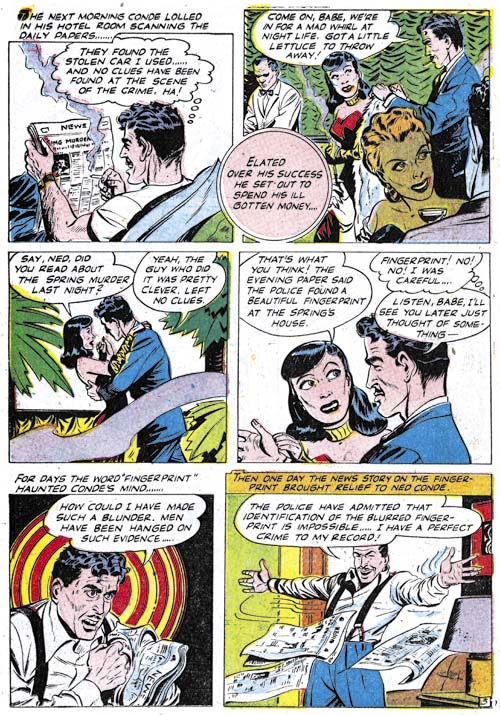
Headline #24 (May 1947) “Grim Pay-Off For The Pinball Mob” page 3, pencils and inks by Jack Kirby
There is one coloring peculiarity whose significance I am still uncertain of that appears during the early crime Headline period. It concerns the use of middle cyan (C50) as hair coloring. The limited palette available for coloring presented a problem when it came to depicting black hair. The problem was not that black was unavailable but rather that using black alone would result in a massive black with no distinction for strands of hair. The convention most comic colorists adopted to circumvent this problem was to use cyan (C) or blue (CM25) to represent black hair. Technically not truly accurate but a convention so widely used that comic book readers took it for granted. This use of cyan or blue to represent black hair is followed in most Simon and Kirby crime stories, but not all. Some stories feature the use of middle cyan (C50) instead. This unusual choice was not an accidental misread by the printer of the original color guide. The presence of pure cyan (C) on the same pages of middle cyan (C50) hair indicates that this was in fact the colorist’s intent. Nor does this seem to be an attempt at representing gray hair. While middle cyan (C50) works quite nicely as gray hair it was used primarily on people with an otherwise young appearance. Further I have not yet found a story which used middle cyan (C50) and either cyan (C) or blue (CM25) for hair coloring. What is less clear is what this use of different hair coloring signifies. Does it indicate two different colorists at work or one colorists purposely adding a little variation to his output? I am still undecided but so far I have recognized no other coloring distinctions between the stories with the two ways of indicating black hair.

Headline #26 (September 1947) “Beyond The Law” page 3, art by unidentified artist
In the previous chapter I mentioned the occasional unusual coloring of people in the early Prize crime comics. I wondered if the same special color was ever done on artwork not drawn by Jack Kirby. A search reveal only a few. I do not make much out of their scarcity as unusually colored people are pretty rare even in the Kirby drawn material. Further most of the examples are found in the earliest issues of the crime version of Headline; issues that Kirby drew most or all of the work. By the time other artists were frequently used less effort seemed to have been expended on the coloring and such unusual coloring of people was no longer done. Still the presence of unusually coloring in material not drawn by Kirby conforms with my believe that the same colorist worked on both Kirby and non-Kirby material.

Color Palette used by Prize for Headline (starting in June 1948)
In the previous chapters I discussed the coloring used in Simon and Kirby crime comics published by Hillman and Prize. Since this material was published during the same period (March to September 1947) differences in the coloring can safely be attributed to the presence of different colorists. However for the period that follows only Prize published Simon and Kirby crime comics. Under these conditions it become less certain that changes in coloring would indicate different colorists. Such changes might also indicate the evolution of a single colorist style.

Headline #30 (June 1948) “Bullet-Proof Bad Man” page 3, pencils by Jack Kirby
One coloring change that is found in the later period and does seem to be significant is the appearance of the use of pale green (C25Y25). The use of pale green (C25Y25) and pale yellow (Y25) was an important distinction between the Hillman and Prize colorists. Now pale green appears does appear in Prize crime comics but without pale yellow. Further studies are needed, but at this time I find no obvious differences between the coloring. So was this just the evolution of the style used by a single colorist or a change of colorists? I am not ready to hazard a guess at this time.
I consider these three chapters on Simon and Kirby colorists as just an initial step. Much further studies are needed. Of particular interest would be around 1954 when Simon and Kirby were producing comics for Prize and Mainline (there own publishing company). This would provide another chance to compare coloring from two different publishers from the same time period. I am not sure when, but I will be returning to this topic sometime in the future.


Impressive, as usual. I wait for further results.